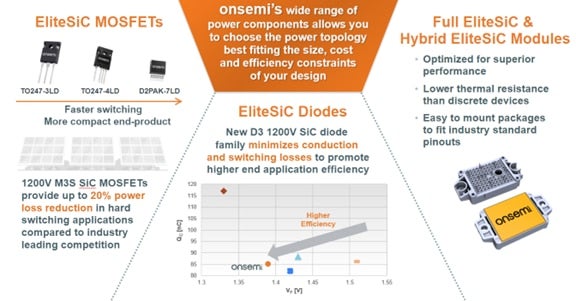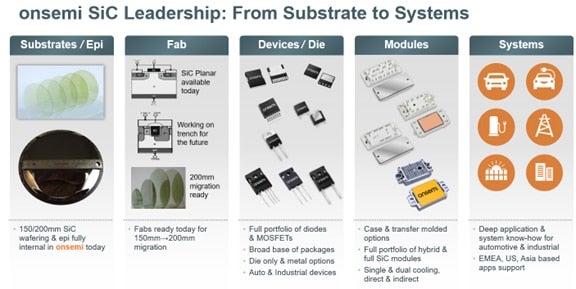Years ago, designers relied on a basic datasheet and their training / knowledge to select and incorporate a component into a design. These days, many semiconductor companies have recognized the pressure on designers to deliver complex designs to market in ever-reducing timescales and now offer a full ecosystem of design support tools. Depending upon the technology involved, and the manufacturer, these may include evaluation boards/kits, SPICE models and simulation tools, reference designs, selection guides, application notes and other valuable materials.
Of course, new technologies take time to mature and for their support ecosystems to expand. Many continue to see Silicon Carbide (SiC) as a “new” technology, presumably as it is used extensively in high power conversion applications such as renewables and electric vehicles, and assume that there is little, if any, support ecosystem available.
SiC Product Portfolio
Any ecosystem starts with the available product portfolio – many assume that for SiC this is restricted to a limited range of MOSFETs and diodes. A quick glance at onsemi’s EliteSiC product line will reveal over 120 diodes of various types with operating voltages up to 1,700 V. Alongside this is over 100 650 V, 900 V and 1,200 V SiC MOSFETs and 30+ power integrated modules (PIM) that are based on onsemi’s own SiC MOSFETs and diodes. Completing the range are other devices such as the all-important gate drivers, such as the NCP51705, that ensure proper operation and maximum performance from SiC devices.
Design and Simulation
These days it is rare to build any form of hardware without first undertaking a computer-based simulation using SPICE models to obtain a reasonable estimate of how a circuit will behave. To support this, onsemi offers physically based, scalable SPICE models for their SiC devices as well as their Elite Power Simulator that provides accurate results with the market-leading EliteSiC devices.
onsemi Physical and Scalable SPICE models are supported by all major industry platforms including PSpice, LTspice, Simetrix, Spectre, ADS, SABER, and Simplorer.
As further support, onsemi has developed a PLECS models generator for system level simulation. Unlike many PLECS models that are only suited to hard switching, onsemi’s Self-Service PLECS Model Generatorenables engineers to create custom high-fidelity PLECS models. The models are equally suited to soft-switching applications such as DC-DC, LLC and CLLC Resonant, Dual Active Bridge, and Phase Shifted Full Bridge (PSFB).
Materials and Supply Chain
Building SiC devices can be challenging, especially with regard to maintaining sufficient process control to avoid reliability issues. This can only be avoided through extensive wafer and product qualification and a good understanding of failure modes combined with effective failure analysis techniques and a program of corrective actions.
onsemi has developed a comprehensive, cross−functional methodology to assess their SiC products before market release based upon a combination of a rigorous design methodology, strict production monitoring, manufacturing control, appropriate screening, and robust qualification.
With the growth of key applications that utilize SiC technology such as automotive and renewable energy, product availability is a concern. The concern seems to be based upon the misperception that SiC products are difficult to manufacture and production capacity is limited. One of the issues is the multi-stage process is often split between different companies. onsemi is a large-scale supplier of SiC and solutions with end-to-end supply capability.
This begins by growing single crystal SiC material to produce wafer substrates in New Hampshire before a thin epi layer is grown, followed by several device processing steps leading to the final stage when products are packaged. The entire onsemi manufacturing process is vertically integrated end-to-end, with exhaustive reliability and quality testing at each step to ensure near-zero defects.
onsemi’s vertically integrated supply chain brings several advantages, including scalability, superior quality, and production cost control. Furthermore, additional quality assurance is provided by defect scanning, which is performed before and after epitaxial growth. Vertical integration also helps ensure that production volumes can be rapidly scaled up and processes are optimized by quickly feeding back status information at each stage of the value chain.
Learn more about EliteSiC. Read “Technical Advantages of onsemi's New Elite Power Simulator and Self-Service PLECS Model Generator” to learn more about the simulation tools.



